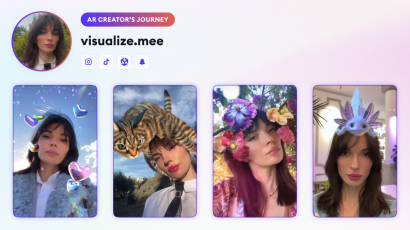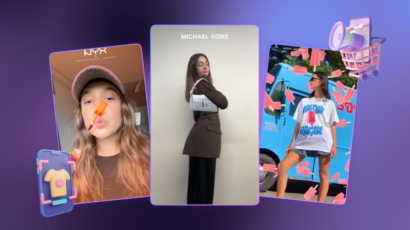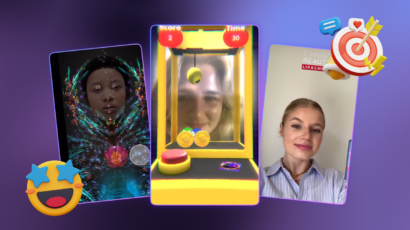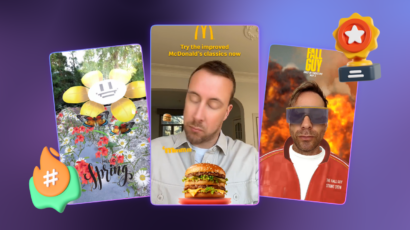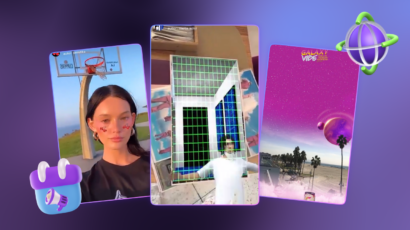Meet visualize.mee, the next guest of AR Creator’s journey blog. She’s a digital artist whose works let you explore and investigate mesmerizing fictional worlds through AR. The heritage of Umberto Eco, the sculpture and architecture of Hellas, and Renaissance paintings are the source of inspiration that is reflected in her art. Visualize.mee is unafraid of novelty and appreciates the freedom to explore and experiment with multiple tools allows her to create anything she envisions.
Learn more about visualize.mee’s AR journey 👇
How did you start your AR journey? How did you discover Augmented Reality? What motivated you to start creation of AR?
It was a while ago, around three years to be precise, when I first began working on augmented reality (AR) technology. I desired to try something novel, as I had previously been working on 3D renders and wasn’t contented with just posting my works on social media. With AR I was able to share my projects on the platforms like Instagram, Snapchat and connect with people in a new way. The ability to explore and investigate mesmerizing fictional worlds through AR provides users with a unique vision of themselves and reality that was augmented.
How did your classical art background reflect in your AR work?
I find the distinction between classical and digital art or augmented reality (AR) not so meaningful. It’s more about the tools, techniques, and software that I use. The most essential aspects of work process are my vision, experience of life, and art taste. They are the primary driving forces behind my work, regardless of the medium I am using.
What Is AR for you?
I guess working with augmented reality (AR) is relaxing, enjoyable and pleasing at the same time. When I feel bored or uninspired, creating 3D objects and filters can be a great way to engage my mind and keep me occupied. It’s almost like a form of meditation and concentration. Additionally, when other people appreciate my work and give positive feedback, it makes me feel confident and proud of what I’ve created.
What or who is your inspiration and what are your biggest influences?
Inspiration can come from anywhere, all you need is the motivation to find it. Involvement and inspiration descend from visiting museums, exploring different places, and cultures around the world. I have a particular interest in discovering objects with historical and art significance. I have a multi-gigabyte collection of different artifacts, for instance, vintage keys, antique furniture, exquisite porcelain, intricate chess figures, forgotten manuscripts, ancient geographical maps that I often use as a starting point for creating new works. I am fond of the heritage of Umberto Eco, sculpture and architecture of Hellas, and Renaissance paintings, this list could be endless.
What sets you apart from other creators?
It’s hard for me to compare my own personality to other creators, because I have a great deal of respect for everyone in the community. I am also quite shy to talk about myself in this way.
As for my artistic style, I would say that it’s a fanciable cocktail of hyperrealism, surrealism, my own perspective and understanding of life, and 1% is a combination of chance and my current mood.
How would you describe your work, do you have a specific style? Does it change over time?
I hope that my work is helpful and uplifting for those who view it. I strive for it to be free of negative influences and for everyone who sees it to feel inspired, comfortable and happy. I want people to have a sense of eternity and timelessness when they look at my art.
When did you realize that you had reached a turning point in successfully creating augmented reality? What helped you with this?
I believe my experience with creating augmented reality (AR) began when I started working with the SnapAR platform. The features available on Lens Studio were quite different from those in Spark AR, and after learning to use them, I moved on to work with Unity. Through connecting with these various types of software, I had come to conceive that there was no need to limit oneself to just one particular software. The freedom to explore and experiment with multiple tools allows you to create anything you can envision. It’s substantial as well to have the ability to make what you need on your own, rather than relying on others for help. This freedom in art and development is my clue for personal growth and artistic expression.
What do you think of collaborations?
I am quite open to prospects for collaboration, but it will rely on my schedule and current financial position. Although working with others can be a highly fulfilling and enlightening experience, it can also consume a sizable chunk of my working hours.
Which brands have you worked with in fashion industry?
I have to say that I have been involved in some very exciting projects in the past. One of the highlights was working with Simone Studio in London on various lens projects.
One of which was a very complex and challenging lens for Prada on Snapchat. Another notable project was the filter we created for Carolina Herrera, which was also rather complicated. It was a makeup filter with tricky logic inside, which was an interesting experience for me.
Tell us about the projects you’re most proud of and what makes them special?
I love all my world-AR works, as they come from within me. I spend a lot of time on these projects, pouring my heart into them. And after each project, I feel appreciation and pride for the works I have created.
Describe your working process. Do you follow the work spontaneously, or do you have a plan that you follow?
The working process can be intricate for me as it can sometimes go in unexpected directions. For example, I might have many references open on my computer for a new project but then decide not to use them, while other times I can create a whole project with just one image. It depends on the specific needs of the project, my motivation, and other feelings.
As a general approach, I prepare different views for each model and then locate them in the references. Next, I create the high-poly model using sculpture techniques, then I make a low-quality model with baked normal maps, then I draw diffuse textures, after all these manipulations, I have the final model. The last step is animation, being the most engaging piece of the work, which takes a major part of my time, as it blows life into a silent chunk of digital substance. Finally, I bring together all the existing assets of the project in the AR program.
I pursue creating multiple concepts within one project with various visions, so the client has options to choose from. As we can never know what exactly is in someone’s mind, this approach helps to cater to the needs and preferences of the client.
How immense is the future of AR generally? In fashion?
I believe the fashion industry will increasingly utilize augmented reality (AR) in conjunction with other technologies such as artificial intelligence (AI) in the coming years. I anticipate that 2023 will be an exciting year for these advancements, especially with the emergence of new technologies like quantum computers and new ways of processing data. This will open up new opportunities for brands to understand their customers better and tailor their products to their preferences. Brands will use this information in legal and ethical ways to improve their marketing strategies and engage customers through AR experiences. This will lead to a more personalized shopping experience and increased customer satisfaction.
Have you already had experience with working on a project when both AR and AI are included?
I haven’t worked with AR and AI together yet. To tell the truth, I simply avoid using AI at the moment because I need to abstain utilization of other artists’ works without their permission. Hence I prefer to collaborate with my own intelligence inside my brain instead of AI tools. I believe the absolute highlight of the whole work is the creative mind of the artist. What will be in the bottom line and quintessence of the work if the concept is created by AI?
Which are the industries that will be most influenced by AR?
I think healthcare is the most valuable area of AR application in the future. Studying medicine offline is tough and complicated. The use of augmented reality technology allows a better understanding and interaction with the various systems and structures within the human body with the help of body trackers.
Do you have any tips for AR beginners when it comes to creating filters or working with clients?
Believing in oneself is crucial for success. It is a very strong foundation for any endeavor. Whereas immediate results may not be visible, consistent practice and perseverance will ultimately lead to the ability to achieve one’s goals.
We wish visualize.mee the best of luck. 💜 Don’t miss the previous AR journey blog. Get inspired by our creators!
